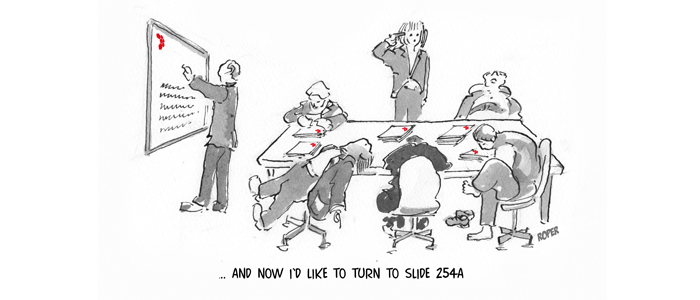It’s important to keep meetings short and snappy as people begin to switch off after 30 minutes. This guest blog post from Olive Keogh in The Irish Times explains why.
“A meeting is an event at which the minutes are kept and the hours are lost.” This pithy little quote is attributed to that wise old sage, Anonymous, and it’s apposite. Most meetings go on for too long.
The main culprit often is the human tendency to waffle. A second culprit, if one believes the views of US management coach Dale Dauten, is that “a meeting moves at the speed of the slowest mind in the room”.
Most people don’t like meetings but they are a necessary evil not least because they provide the environment where an organisations’s culture is asserted and assimilated.
Changes in the structure of today’s workplace (where fewer people are doing more tasks) have led to more team-based processes and teams need meetings to liaise and do their work. However, if people end up counting the wall panels to stay awake, they are unlikely to return to their desks motivated or energised.
The brain likes its rations in small bites and there is ample evidence that focus and attention drop off rapidly after half an hour. From its start to 30 minutes into a meeting, roughly 84 per cent of people will still be engaged. By minute 45 this is down to 64 per cent.
“All else being equal, meetings should be based on what people can sensibly stand so one and a half to two hours maximum,” says Kate Mercer, director of Leaders Lab and author of A Buzz in the Building: How to Build and Lead a Brilliant Organisation.
Leadership
“Received wisdom says a meeting should be as long as it needs to be to get the work done. However, this ignores the old maxim that work will always expand to fit the time available. It also lets us off the hook on taking leadership of a meeting and stipulating how much time we are willing to allow for it.”
For Mercer, setting a right agenda is crucial. “An agenda should be no longer than three substantive items. If there’s more to discuss, have more meetings but short, sharp ones. If half or one-day meetings are necessary, then [there should be] no more than five agenda items for a half-day and eight for a full day,” she says.
What some people forget is that meetings cost money. Take the example of an hour-long weekly meeting involving six senior managers. If their salaries are combined and expressed as a cost per hour, their annual meeting bill alone will run into thousands of euro before any other meetings are factored in.
Meetings should start with a clear purpose and end with the clear allocation of tasks. Those with straightforward agendas should last no more than 30 minutes and, as one meeting veteran puts it: “Personally I would never call a meeting without knowing exactly what I want or need from it.”
To ensure meetings end on schedule, close them down five minutes before the designated end time. This allows people to be on time for their next appointment.
Regular breaks
Where longer meetings are needed to tackle more complex issues, include regular breaks of five-10 minutes for people to make a call or check their emails. This reduces the anxiety factor in the room.
Meetings should be followed up with minutes, if appropriate, and progress monitoring on assigned tasks. If a new issue arises that’s outside the agenda, it should be listed for a separate meeting.
“Where possible, kill AOB – Any Other Business. It’s often an excuse for lack of preparation and an opportunity for some to hijack events,” says Tony Shone, director of management training company, Invisio.
“At the beginning of a meeting, check in with attendees if anything urgent has arisen. Then decide if it needs to be dealt with or requires a separate conversation when people are prepared. If the meeting is to stick to its allocated time, items may need to be deferred.”
A classic time waster in meetings is the PowerPoint presentation so consider limiting its use. Most users put too much information on their slides and, as a result, people’s brains switch off, they get restless and it doesn’t take long for disengagement to spread throughout the group.
“Some companies are now taking a lean approach to meetings and this can work, provided the culture is also addressed,” Shone says.
“Lean meetings may include a time-keeper in the form of a speaking clock that alerts people when the time specified for an item is coming to an end and a decision is needed.
“These organisations are ruthless in their meeting execution and their ground rules for efficient meeting management are often displayed in the meeting room – next to a BIG clock.”
Meeting musts
- Prepare. Set a realistic agenda and circulate it.
- Have a definite purpose – ie to make a decision, agree an action plan or impart information.
- Keep meetings short. Engagement diminishes after 30 minutes.
- Routine meetings should last 30-60 minutes.
- Longer, strategic meetings requiring brainstorming are best held off site and should be facilitated if tough conversations are necessary.
- Don’t let meetings be derailed by side issues.
- Have action-based objectives not just talk.
- If your organisation is “bad” at meetings, hire a facilitator to keep them on track.
- End meetings five minutes early.

